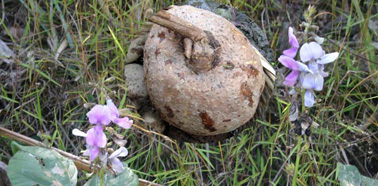|
Botanical Name:
Pueraria tuberosa
Vidarikanda is the dried tuber of Pueraria tuberosa DC,
Family Fabaceae
Common Name(s) in English & Indian Languages
Sanskrit: Ikdugandhs, Vidari
Assamese: Bhui Komora
Bengali: Shimiya, Shimiabatraji, Bhui Kumdo
English: Indian Kudju
Gujarati: Khakharvel, Vidaree, Vidareekand
Hindi: Vidareekand, Bilaikand, Sural, Patal Kand
Kannada: Bhoosakkare Gedde, Bidrerakanda, Dari, Gumadi Gida,
Gummadi Balli
Malayalam: Mutukku, Palmutukku
Marathi: Bendriya Bel, Bindree, Vendrichavel
Oriya: Patal Kumda
Punjabi: Siali
Tamil: Nilpushni Kezhugu
Telugu: Nelagummudu
Urdu: Badarikand
Botanical description:
It is a large perennial climbing, coiling and trailing vine
with large tuberous roots. The tubers are globes or
pot-like, about 25 centimetres (9.8 in) across and the
insides are white, starchy and mildly sweet. Leaves are
trifoliate and alternate, while the leaflets are egg-shaped,
with round base and unequal sides. They are 18 cm (7.1 in)
long and 16 cm (6.3 in) wide and are hairless above. Flowers
are bisexual, around 1.5 cm (0.59 in) across and blue or
purplish-blue in color. The fruit pods are linear, about 2–5
cm (0.79–2.0 in) long and constricted densely between the
seeds. They have silky, bristly reddish-brown hair. Seeds
vary from 3 to 6 in number.
Parts used:
Tuber, Roots
Major chemical constituent:
Gluconic and Malic acids
Therapeutic uses:
• Pain (Sula)
• Burning sensation (Daha)
• Cough (Kasa)
• Pthisis (Ksaya)
• Dysuria (Mutrakrcchra)
• Vitiation of Blood and its components (Raktadosa)
• Bleeding disorder (Raktapitta)
• Intermittent fever (Visamajvara)
• Erysepales (Visarpa)
• Deficiency of semen (Sukraksaya) |
|
 |
|
|



